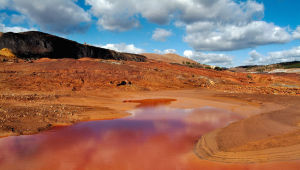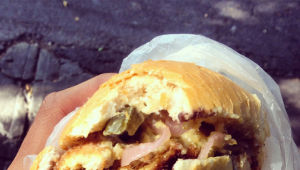In our tent 5000meters above sea level, myself and my team mates get ready for the night ahead. Everything is done in silence under a dim head torch and candle light, its pitch black outside. Itamar pulls his draw cord tight on his sleeping bag and lays down in a mass of rucksacks, roll mats and spare clothing. He’s the lucky one; he gets to rest in the middle of us while I anticipate a cold night sleeping pressed against the wall of the tent. I pull my sleeping bag up to my waist, and fasten every bit of Velcro and string on my synthetic down jacket to try and block out the cold. I lean out of the tent and in the porch begin chipping away the ice from my boots so I can use them as a pillow during the night. Hopefully it will keep them relatively warm so they are not too stiff or cold in the morning. As the ice breaks away and the candle flickers, a feeling of calm and tranquillity occupies my whole mind and body. I want or need nothing, I have it all, chipping the ice off from between the tread of my boot gives me satisfaction, I’m fed and I have shelter and I just watched the sunset over the Himalayas; an ocean of mountains as far as the eye can see, where the continents collide and the borders of nations are formed. Tomorrow, in the early hours of the morning we will ascend Ruddugaira at 5845 meters, by no means a certainty but we will approach it with confidence as this is our consolation peak, a ‘breakfast peak’ after three of the most challenging weeks of my life so far and a failed attempt on Gangotri III in the Garwhal region of India.
It had been three weeks since I left the green fields and horses of the Yorkshire Dales to the heat, dust and holy cows of India which was then followed by the ice, snow and acute mountain sickness of base camp at 4200 meters. I was invited to attend an international climbing camp by the Indian Mountaineering Foundation as a participant on their Himalayan Alpine Climbing course to be held at The Nehru Institute for Mountaineering.
NIM, an Indian equivalent to Plas Y Brenin based in Uttarkashi, provided instructors equipment and logistical support for the course. Among the staff were guest instructors from Canada and the Italian Alpine club as well as Colonel Balwant Sandhu, no less than a living legend. At 72 years old he still stood tall and strong and talked like a true gentlemen that ironically made you proud to be British. An Indian Paratrooper who had made the first ascent of Changabang with Chris Bonington, Dougal Haston and Co. as well as being the expedition leader during the first female ascent of Nanda Devi. He still had the spirit; the spirit of adventure most people lose, a disregard for fear and danger, just an insatiable curiosity coupled with the dignity and presence you would expect from a Colonel in the Army.
Stuck in an era of old school, siege style tactics, the staff at NIM were just as keen to learn from the guest instructors as we were. I suspected this was one of the reasons why the course was taking place, a matter of national pride, too many foreigners claiming Indian peaks for themselves. India is an up and coming economy and the rising tide requires all aspects of their culture to rise with it, to be at the cutting edge and at the forefront gaining recognition and status in the World rankings. This course aimed to plant the seed of Alpinism in the minds of young Indian mountaineers, some of whom didn’t even believe Alpine style climbing as a possibility in the Himalayas due to the altitude and scale. Everest or Kanchenjunga was all the Indian participants cared about, what kind of style didn’t matter. For me, as time went on, I would learn more about siege style climbing than anything else. Old habits, it would appear, die hard, especially with a caravan of fifty people making true Alpine style impossible.
More...
Base camp was established at 4200m and from here the group enjoyed excellent food provided by the porters, a series of acclimatisation treks/load ferries and practical sessions and talks on glacier travel, crevasse rescue, abseiling and ice climbing. Sometimes the instruction by the local instructors seemed to be quite dubious with obvious oversights to safety in some cases. However the guest instructors had a lot to offer as did C. Norbu a senior instructor at NIM, it was obvious why he held the position having been trained by Tenzing Norgay at the Darjeeling Institute of Mountaineering, another training centre in India. Being the only foreign national there for a time (before the late arrival of two Iranians and one Israeli) I occasionally sat in the staff tent/kitchen and sat in admiration as Col. Sandhu talked about his Himalayan adventures with humility and soberness and about his near-death experiences, not that he would ever describe them like that.
Eventually the time came to do what we came here to do, try and summit a +6500m peak. Gangotri I & III were the objectives for participants up for a challenge, Ruddugaira at 5845m would be climbed by those who were not. Dividing into three groups I was among a small group aiming for G3; a more aesthetically pleasing mountain. A large group headed for G1, true to Indian form, simply because it was higher by 120m or so. The rest would successfully attempt Ruddugaira.
I had huge concerns about our attempt on G3. The only thing that had tipped the balance in favour of going was that C. Norbu had decided to join the team and come with us. After our recce earlier on the expedition, we had identified a significant avalanche risk, but Norbu had said he had seen another line which would avoid the danger area. Despite the avalanche risk my other doubts lie in the equipment we had been issued as well as my boots; a sewn through sleeping bag a foot too short for me, tents that were no better than an Argos family car camping tent and my summer alpine boots with over-gaiters, not quite suitable for winter high altitude climbing. Regardless we set off with sacks surely over 20kg (again hardly alpine, but it would be self-sufficient from now on.) and made our way to camp I.
I let off a Lion’s roar as a joke as I was feeling good, strong and hungry for more.
Avoiding the avalanche prone areas meant ascending a steep slope to gain a ridge, an alluvium on the banks of the glacier. Gaining the ridge proved difficult because of the dry, powdery snow, each step collapsing underfoot, concentration and patience were required to avoid a travel-ator effect leaving one gasping for air. We were on the lee, up to our chests in snow and then over a small but difficult rock step, we were on high, safer ground. I let off a Lion’s roar as a joke as I was feeling good, strong and hungry for more. The mountains make you appreciate things you take for granted and I was definitely appreciating my health at that moment after what felt like an eternity of AMS. We had a short break and moved on. The storms had been arriving earlier every day and today they arrived at their earliest at around 10.00am. We continued to move trying to reach the basin we were aiming for, the cold driving winds numbing our noses and cheeks. The wind and hail worsened and persisted, it was time to hunker down. Out came the Argos-esque tents and we began trying to pitch them, filling the stuff sacks with snow trying to create dead man anchors to hold them down. The snow was so dry and the tents so poor, it took a lot of work in the howling winds to get the tent in a useable state. In the end it was good enough to get into but they wouldn’t be good enough to go any higher that was obvious, not with daily squalls like this. We would have to go back, before we’d even got established on the route. We returned, tail between our legs finding no consolation in quoting “Success is getting down safely and staying alive” although I was happy I was more likely to keep my toes.
Back at base camp I heard the G1 team on the radio as Col. Sandhu was in the background saying to the base camp operator;
“Tell them to put the radio down, they shouldn’t need their hand holding, they should just get on with it.”
Followed by;
“It’s just a sit rep I requested Sir.”
“Mmm, that’s okay then.” was his response.
The G1 team were living by NIM’s tag line; “Success Lies in Courage.” Pushing on and fighting through the elements, a fuel and therefore water and food shortage, AMS amongst some of the strongest climbers, several people with various degrees of frostbite, one member with a broken hand and overdue by so much that we would summit Ruddugaira and be back at base camp again before they returned. They gave me a lot to think about.
A Health and Safety officer would have had a field day with their ascent but the bottom line is they had succeeded and they all survived and they would all recover
Their approach could have be described as ‘reckless’ or ‘foolish’ but instead when they returned everyone at base camp had nothing but respect for them and they deserved it. They filled me with inspiration; their robustness, determination and their perseverance. They did struggle but decided to carry on and they succeeded, with identical equipment to our own. Admittedly some had been to high altitude before and I don’t regret our decision but it was a reminder, not of what a stylish alpine ascent is, but about what the spirit of adventure is. They were reminiscent of the early day pioneers in The Alps, climbing ridiculous routes by today’s standards, only using hemp ropes and three pegs and generally being ‘hard as nails’ but humble with it. A Health and Safety officer would have had a field day with their ascent but the bottom line is they had succeeded and they all survived and they would all recover, after all a little pain never hurt anyone. Success, it appears, may indeed lie within courage (Even now my Western mind is screaming; yes but with skill, technique, risk management and the right equipment for the job... have I just been indoctrinated, is courage all one needs?).
Back at 5000m in our tent after a surprisingly undisturbed sleep, we began to get ready in the darkness for our ascent of Ruddugaira, as did several other tent groups surrounding us. It was impossible not to knock the tent wall in anyway and when one did, the frozen condensation would fall from the sides making it snow inside. We set off, feeling well acclimatised but still noticing the thinner air, stopping only to add layers we kept moving, begging the sun to hurry up across the valley and warm our bones as it rose, rising a lot slower than normal or so it felt.
We kept moving, keeping a good pace, maintaining a rhythm, not allowing ourselves to get out-of-breath. Two more from our group were ahead and appeared to be on the summit. I turned around and was blown away by a magnificent view of Thalay Sagar appearing so close and lucid, I hadn’t known it had been in the next valley the whole time, only now could you see it. A few more steps and I were also on the summit. Incredible! Never had I stood on a mountain where the summit had been so small, so close to a point, my first real mountain! It was a fantastic feeling, pure joy. I wanted to stay but my feet had been cold the whole day and I had lost feeling in them now. Not sure of the consequences I headed back down the mountain to camp so I could massage my feet and drink tea. Afterwards it was time to head to base camp and then on to home, all three teams reaching the summit of something if not over 6000m.



